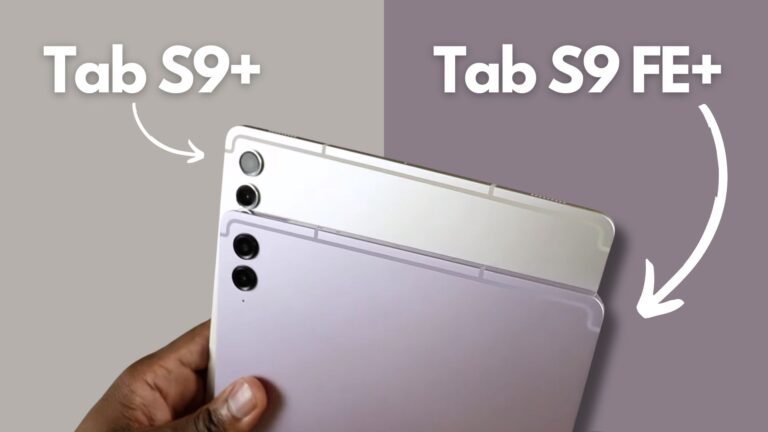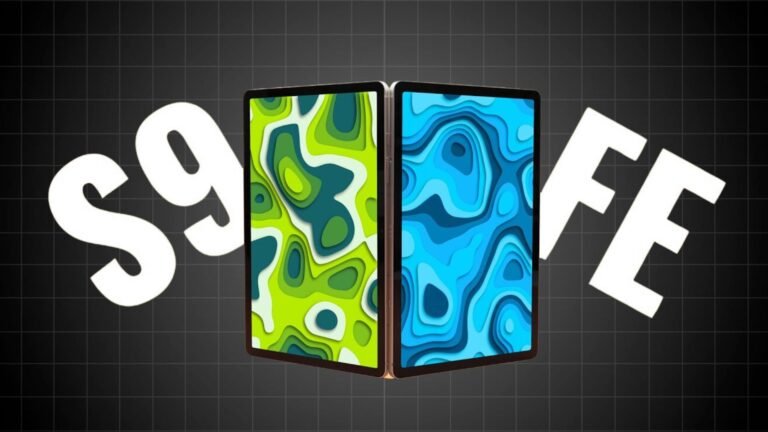In this article, I will be comparing Google’s new Pixel Tablet with the iPad 9, and at first, I thought that it wasn’t really a fair comparison because the iPad 9 is almost two years old and it’s also a lot less expensive, but the more I thought about it I realized that maybe the cheaper tablet is actually better.
Starting with the price tag, the Pixel Tablet is priced at $499, while the iPad 9 sits at $329. These are the standard prices in the US. It’s worth noting that the base model of the iPad offers 64GB of storage, whereas the Pixel Tablet begins with 128GB, with both having a 256GB variant.
| Pixel Tablet | iPad 9 |
 |  |
| PROS | PROS |
| Charging speaker dock. Better Speakers. Better Display. | More affordable. Better Performance. Crisper front-facing camera. |
| CONS | CONS |
| Expensive. No headphone jack. No Keyboard Option. | Old Design. No USB-C. |
| Buy Now | Buy Now |
Specifications
| Pixel Tablet | iPad 9 | |
| Price | $499 | $329.00 |
| Storage | 128GB, 256GB | 64GB, 256GB |
| Screen size (inches) | 10.95 | 10.2 |
| Screen resolution (pixels) | 2560 x 1600 at 276 ppi | 2160 x 1620 at 264 ppi Retina |
| Screen brightness (nits) | 500 | 500 |
| Dimensions (inches) | 10.2 x 6.7 x 0.3 | 9.8 x 6.8 x 0.29 |
| Weight (pounds) | 1.086 | 1.07 |
| Battery (hours) | Up to 12 | Up to 10 |
| Processor | Google Tensor G2, Titan M2 security coprocessor | A13 Bionic |
| Rear camera | 8MP | 8MP Wide |
| Front camera | 8MP | 12MP Ultra Wide Center Stage |
| Speakers | Quad speakers | Two speaker |
| Microphones | 3 with noise suppression | 2 |
| Video recording | 1080p at 30fps (front and rear) | 1080p at 25 or 30 fps (rear) 1080p at 25 fps, 30 fps, or 60 fps (front) |
| Connectivity | Wi-Fi 6, Bluetooth, Ultra-Wideband | Wi-Fi 5, 4G LTE, Bluetooth 4.2 |
| Ports | USB-C 3.2 Gen 1, 4-pin accessory connector | Lightning, Smart Connector |
| Biometric | Power-button fingerprint sensor | Touch ID |
| Stylus support | USI 2.0 stylus pen support | First generation Apple Pencil |
| Colors | Porcelain, Hazel, Rose | Silver, Space Gray |
Design & Build

Aesthetically speaking, both tablets sport curved edges. However, the iPad retains sizable bezels at the top and bottom, in contrast to the Pixel Tablet’s consistently thin bezels. Both devices boast a solid build, featuring an aluminum back and frame. The Pixel Tablet, however, stands out with its elegant nano ceramic finish, which I think looks great.
The iPad is available in silver and space gray, while the Pixel Tablet offers shades like porcelain, rose, and hazel. For user authentication, both devices employ fingerprint sensors. The Pixel Tablet’s sensor is seamlessly integrated into its power button, while the iPad 9 retains its traditional home button.
The Pixel Tablet opts for a USB-C port, leaving the iPad with its lightning port. This gives the Pixel Tablet an edge in this category.
Speakers & Audio
When diving into the audio capabilities, the iPad features a dual-speaker setup, both located at the bottom. This means that when you’re engrossed in a movie or gaming in landscape orientation, the sound predominantly emerges from one side. In contrast, the Pixel Tablet boasts a quad-speaker system, with a pair on each side, delivering a more immersive stereo experience. Moreover, the sound quality on the Pixel Tablet is noticeably superior.
However, the iPad does score a point in the audio department with its inclusion of the 3.5mm headphone jack. This allows users to plug in their wired headphones or headsets without the hassle of an adapter.
Display Difference

Shifting our focus to the screens, both tablets, despite having a comparable size, exhibit distinct differences. Both feature 60Hz LCD screens, but the Pixel Tablet’s display is larger and offers a sharper resolution and greater pixel density. Both screens peak at a brightness of 500 NITS, ensuring similar performance outdoors or in reflective environments.
The aspect ratios differ as well. The iPad 9 sports roughly a 4:3 ratio, while the Pixel Tablet leans towards a 16:10 ratio. This means that movies or videos on the Pixel Tablet occupy more screen space, minimizing the black bars at the top and bottom.
A noteworthy distinction is the Pixel Tablet’s fully laminated display, where the screen, touch layer, and protective glass merge into one unit. The iPad 9, on the other hand, has a discernible air gap between its display and the combined touch layer and glass. While this might not be evident during routine tasks like web browsing or gaming, it becomes apparent when using a stylus on the iPad 9. The separation between the stylus tip and the resulting content is visible, especially from an angle. The Pixel Tablet offers a more direct experience, making it seem as though the content is being drawn directly on the glass surface.
Accessories

Diving into the realm of stylus compatibility, the iPad 9 pairs with the first-generation Apple Pencil, priced at $100. On the other hand, the Pixel Tablet works with USI 2.0 stylus pens, with my chosen pen costing approximately $50. It’s a bit tricky to crown a clear winner in this category since the Pixel Tablet doesn’t have a standard stylus. The performance could vary based on the specific pen you opt for. For my needs, which primarily involve jotting down notes and occasional sketching, I didn’t discern a significant difference between the two.
Transitioning to the topic of keyboard cases, as of now, Google hasn’t released an official keyboard case for the Pixel Tablet. However, I’m optimistic about third-party alternatives emerging soon. For the iPad 9, Apple offers the Smart Keyboard, which isn’t my favorite in terms of design. I find myself gravitating more towards the Logitech Slim Folio and Combo Touch.

An intriguing addition to the Pixel Tablet is its charging speaker dock. This accessory, priced at $128 if purchased separately, not only wirelessly charges the Pixel Tablet but also elevates it for an optimal viewing experience. Furthermore, when the tablet is docked, it doubles as a speaker, enhancing the audio output. It’s worth noting that this dock can potentially replace a Nest Hub Max for those contemplating such a purchase.
Cameras & Battery Life
Now moving on to the camera systems, both tablets have an 8MP Rear facing camera. The Pixel Tablet comes with an 8MP front facing camera and the iPad 9 comes with a 12MP front facing camera. I like the position of the Pixel Tablet camera better because it’s on the long edge, so you’re always properly framed.
Now looking at battery life both have been very good for me, the iPad is rated for 10 hours, the Pixel Tablet is rated for 12 hours, and based on my tests, I’m gonna give this slight edge to the iPad.
Performance & Software
Now moving on to processing power, the iPad 9 is powered by the A13 Bionic and it has 3GB of RAM. The Pixel Tablet uses the Tensor G2 chip, and it comes with 8GB of RAM. So, let’s quickly look at benchmarks.

The older iPad 9 actually outscores the Pixel Tablet for single and multi-core performance, it also comes out ahead when we look at GPU performance.
But that’s just benchmarks what about actual real-life use? So, for the vast majority of things, I haven’t really noticed a major difference. Both tablets are responsive, the apps open quickly, and then switching between apps and multitasking works really well.
A pivotal aspect to consider is the longevity of OS and security updates. The iPad has traditionally excelled in this domain. Meanwhile, Google commits to Android updates for the Pixel Tablet until at least June 2026 and security patches until June 2028.
When it comes to multitasking, it’s essential to set realistic expectations given that these are entry to mid-range tablets. Both devices support side-by-side app usage and feature a UI dock for swift app transitions. However, the iPad takes it up a notch with advanced functionalities like popup and slide-over windows.
Now both tablets allow you to share files with nearby devices, but the iPad can be used as an external display for your Mac or MacBook using Apple’s Sidecar. What the Pixel Tablet has going for it is Hub Mode, so when the tablet is docked this essentially turns it into a smart hub, and an even more important advantage is the ability to create multiple users. So, in a typical household, you may want more than one person to use the same tablet, but at the same time you don’t really want them to have access to all your files, information, and all of your apps. So, with the Pixel Tablet you can set up multiple users, and each one will get their own apps.
Now speaking of apps in general, the iPad retains its lead. While both the Google Play Store and Apple App Store are brimming with options, apps on the iPad seem to be more finely tuned for tablet usage.
How should you choose?
The Pixel Tablet has a larger, higher resolution and fully laminated display, it comes with a charging speaker doc which can double as a smart hub, it has better speakers, it comes with twice the internal storage so you have more room for the files, apps, and games that you want, and you’re able to have multiple users. The iPad 9 is a lot less expensive, it has a more powerful chip, a higher resolution selfie camera, optional keyboard cases, it comes with a headphone jack, and there are models with cellular connectivity.
The choice boils down to individual preferences and priorities. Whether it’s the allure of enhanced multimedia features and user flexibility of the Pixel Tablet or the power-packed performance and added functionalities of the iPad 9, both tablets have their unique strengths.
Now, you should read: Pixel Tablet vs iPad 10






